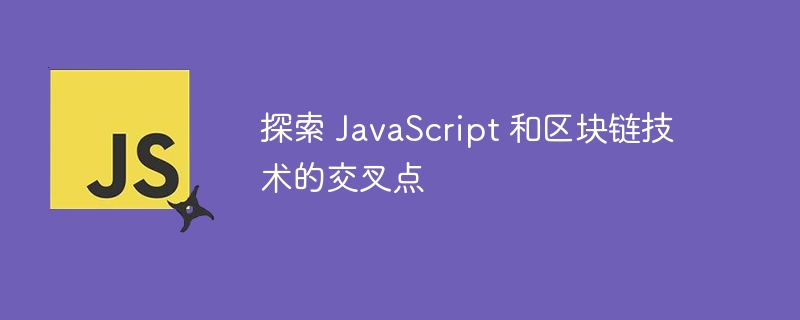

In recent years, blockchain technology has received widespread attention and has revolutionized various industries. Essentially, a blockchain is a decentralized, immutable, and transparent ledger that records transactions across multiple computers. JavaScript is one of the popular programming languages when developing blockchain applications. In this article, we’ll take a deep dive into the intersection of JavaScript and blockchain technology, exploring how to use JavaScript to interact with and develop applications on the blockchain.
Known for its versatility and widespread adoption, JavaScript has become the language of choice for building web applications. Its ability to run on both the server and client sides makes it ideal for creating dynamic and interactive user interfaces. Additionally, JavaScript’s support for asynchronous programming and its extensive ecosystem of libraries make it ideal for blockchain development.
Blockchain technologies such as Ethereum provide a platform for creating decentralized applications (dApps). These dApps often require smart contracts, which are self-executing contracts with predefined rules and conditions. JavaScript can be used to interact with smart contracts, allowing developers to easily build complex and decentralized applications.
Let’s take a closer look at how JavaScript interacts with smart contracts on the Ethereum blockchain. In this demonstration, we will use the web3.js library, a popular JavaScript library for interacting with Ethereum.
First, you need to install Node.js and npm (node package manager) on your computer. After the setup is complete, please follow the steps below−
Open a terminal and navigate to the project directory. Run the following command to install web3.js −
npm install web3
In the JavaScript file, import the web3 library and create an instance of the Web3 class. You also need to specify the provider URL, which determines the Ethereum network you want to connect to. In this example, we will use the Infura service to connect to the Ethereum mainnet -
const Web3 = require('web3');
const providerURL = 'https://mainnet.infura.io/v3/YOUR_INFURA_API_KEY';
const web3 = new Web3(providerURL);
NOTE - Replace YOUR_INFURA_API_KEY with your actual Infura API key. If you don't have one, register for free on the Infura website.
To interact with a smart contract, you need the contract address and its ABI (Application Binary Interface). ABI defines the structure and functionality of smart contracts. In this example, we will use a simple smart contract to store and retrieve the value−
const contractAddress = '0xContractAddress';
const contractABI = [
{
"constant": true,
"inputs": [],
"name": "getValue",
"outputs": [
{
"name": "",
"type": "uint256"
}
],
"payable": false,
"stateMutability": "view",
"type": "function"
},
{
"constant": false,
"inputs": [
{
"name": "_newValue",
"type": "uint256"
}
],
"name": "setValue",
"outputs": [],
"payable": false,
"stateMutability": "nonpayable",
"type": "function"
}
];
Replace 0xContractAddress with the actual address of your deployed smart contract. You can obtain the contract ABI through smart contract source code or tools such as Etherscan.
Now, create a contract instance using the contract address and ABI −
const contract = new web3.eth.Contract(contractABI, contractAddress);
You can use a contract instance to call functions on a smart contract. Let’s retrieve the current value stored in the contract−
contract.methods.getValue().call((error, result) => {
if (error) {
console.error(error);
} else {
console.log('Contract value:', result);
}
});
The getValue() function is a view function, which means it does not modify the blockchain state and can be called without incurring any gas fees. It retrieves the current value stored in the contract and returns it in the result variable.
To modify the value of the contract, you can call the write function. Let’s update the value in the contract−
const newValue = 42;
contract.methods.setValue(newValue).send({ from: '0xYourAddress' })
.on('receipt', (receipt) => {
console.log('Transaction receipt:', receipt);
})
.on('error', (error) => {
console.error('Transaction error:', error);
});
Replace 0xYourAddress with your Ethereum address. The setValue() function is a non-paid function, which means it does not require any ether to be sent with the transaction. We send the transaction using the send() function, and optional event handlers (on('receipt') and on('error')) allow us to receive the transaction receipt or handle any errors that occurred during the transaction. < /p>
When you run the JavaScript code, you will see the output in the console. For example, if we call the getValue() function, the output will be -
Contract value: 10
If we use the setValue() function to update the value, the output will be −
Transaction receipt: {
blockHash: '0x123456...',
blockNumber: 1234,
...
}
The versatility of JavaScript and the power of blockchain technology have come together to enable developers to build decentralized applications using familiar tools. In this article, we explore how to use JavaScript to interact with smart contracts on the Ethereum blockchain. By leveraging libraries like web3.js, developers can connect to the blockchain, interact with smart contracts, and build blockchain-based applications.
The above is the detailed content of Explore the intersection of JavaScript and blockchain technology. For more information, please follow other related articles on the PHP Chinese website!




